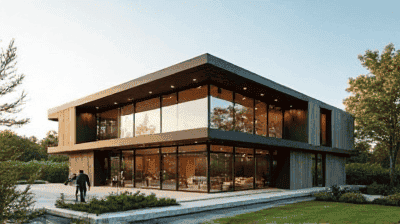
In the face of climate change and increasing urbanization, the concept of 'net zero buildings' has emerged as a vital solution in the quest for sustainable architectural practices. A net zero building is designed to produce as much energy as it consumes over the course of a year, effectively achieving carbon neutrality.
Net zero buildings use a combination of energy-efficient design and renewable energy sources to balance energy consumption and generation. The objective is to minimize ecological footprints and reduce greenhouse gas emissions. Understanding the fundamental aspects of net zero architecture is crucial for grasping its significance in environmental management.
At its core, net zero design integrates five key principles:
Energy Efficiency: Utilization of energy-efficient technologies and building materials to minimize overall energy consumption.
Renewable Energy: Incorporation of renewable energy sources such as solar panels, wind turbines, or geothermal systems.
Sustainable Materials: Use of environmentally friendly building materials that have low embodied energy and are sourced sustainably.
Water Conservation: Implementation of water-saving techniques to reduce resource consumption.
Smart Building Technologies: Integration of smart systems to monitor and optimize energy use in real-time.
These principles not only contribute to carbon neutrality but also improve the quality of indoor environments and enhance occupant comfort.
With over half of the world's population living in urban areas, and urban emissions accounting for approximately 70% of global greenhouse gas emissions, transitioning to net zero buildings is paramount. Here are a few reasons why:
Tackling Climate Change: Buildings are responsible for a significant portion of global carbon emissions. Achieving net zero can substantially lower these emissions.
Energy Security: Reducing reliance on fossil fuels enhances energy independence and security, as net zero buildings can generate their own energy.
Cost Savings: Although upfront costs can be higher, net zero buildings often lead to lower operating costs through energy savings.
Health Benefits: Improved indoor air quality and reduced pollutants contribute to better health outcomes for occupants.
Regulatory Compliance: Increasingly stringent building codes and regulations are pushing the construction industry towards net zero goals.
To achieve the goals of net zero buildings, several innovative technologies are employed. These technologies play a crucial role in enhancing energy efficiency and renewable energy generation.
High-Performance Insulation: Advanced materials that provide superior thermal performance help minimize energy loss.
Efficient HVAC Systems: Heating, ventilation, and air conditioning (HVAC) systems that utilize smart technology to optimize energy use.
LED Lighting: Energy-efficient lighting solutions that consume significantly less electricity compared to traditional options.
Building Automation Systems: Smart controls that adjust energy consumption based on occupancy and usage patterns.
Solar Energy Systems: Photovoltaic (PV) panels convert sunlight into electricity, while solar thermal systems can be used for water heating.
Wind Turbines: Small-scale wind turbines can complement other energy sources to provide additional renewable energy.
Geothermal Systems: These systems utilize the earth’s stable temperature to provide heating and cooling, reducing the need for conventional energy.
Energy Storage Systems: Battery technologies are essential for storing excess energy generated during peak production times, ensuring a steady energy supply.
Success in creating net zero buildings lies not only in technology but also in thoughtful design strategies. Here are key design considerations:
The orientation and layout of a building significantly influence its energy performance. Buildings should be designed to maximize natural light and solar gain while minimizing heat loss. Strategic placement of windows, overhangs, and thermal mass can contribute to energy efficiency.
Employing passive design principles can greatly enhance a building's performance without relying solely on mechanical systems. This includes:
An integrated design approach encourages collaboration among architects, engineers, and contractors from the project's inception. This collaboration fosters innovative solutions and ensures that all aspects of the building contribute to its net zero goals.
To illustrate the principles of net zero buildings, let’s explore a few exemplary projects around the world.
Dubbed the "greenest commercial building in the world," the Bullitt Center is a model for sustainable architecture. Its design features include:
The Bosco Verticale or "Vertical Forest" consists of two residential towers that incorporate significant green space into their architecture. This innovative design includes:
This mixed-use development showcases how urban spaces can achieve net zero goals. Its key features include:
Despite the numerous benefits, achieving net zero status poses several challenges.
The upfront costs of constructing net zero buildings can be prohibitive for some developers. High-quality materials and advanced technologies often lead to an increased initial investment, although this is typically offset by long-term savings.
There is often a lack of understanding and expertise regarding net zero design and construction practices among professionals in the building industry. Increased education and training are essential for overcoming these gaps.
In many regions, building codes and regulations may not yet support or incentivize net zero designs. Advocacy for updated policies is necessary to facilitate the transition to sustainable building practices.
Looking ahead, the push for net zero buildings will likely increase. Here are some trends that may shape the future:
Stricter Regulations: Governments are likely to implement stricter building codes that mandate net zero standards for all new construction.
Increased Use of Smart Technologies: The integration of Internet of Things (IoT) devices will enhance energy management and efficiency.
Collaboration Across Sectors: Partnerships between architects, city planners, and environmental organizations will be crucial in driving net zero initiatives.
Public Awareness: Increased public awareness and demand for sustainable living solutions will propel the development of net zero buildings.
Innovation in Materials: Ongoing research and development of sustainable materials will pave the way for more eco-friendly construction practices.
Net zero buildings represent a crucial step toward creating a sustainable future for urban environments. By combining innovative design, advanced technologies, and renewable energy sources, the architectural community has the opportunity to lead the charge against climate change while improving the quality of life for urban residents. As we strive toward carbon neutrality, net zero buildings not only offer a powerful solution but also serve as a testament to what is possible when sustainability becomes a priority in our built environment.